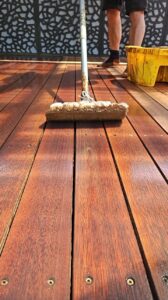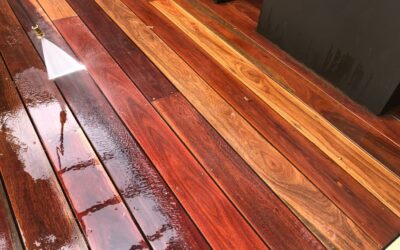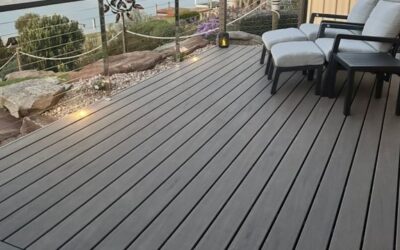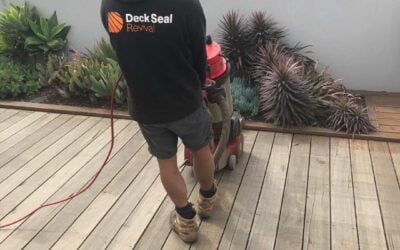During the winter season, it’s crucial to ensure your deck is properly sealed and oiled to maintain its longevity and aesthetic appeal. Freezing temperatures, moisture, and in some areas, snowfall, pose significant challenges to wooden decks. Without enough protection, decks can quickly deteriorate, resulting in issues such as warping, cracking, and mould growth. In this blog, we explore why deck sealing and deck oiling are essential during winter, highlighting the benefits of these preventive measures in preserving your deck’s beauty and structural integrity through the colder months.

Understanding Winter Challenges for Wooden Decks
Winter weather presents substantial challenges for wooden decks. The cold temperatures cause wood to contract, which can lead to cracks and splits if the deck is not adequately sealed. Snow and rain further exacerbate these issues by penetrating the wood fibres, causing them to swell and warp as they absorb moisture. This moisture not only compromises the deck’s structural integrity but also creates ideal conditions for mould and mildew growth, which can tarnish the deck’s appearance and pose potential health risks.
Moreover, the weight of accumulated snow can impose significant stress on the deck, potentially causing it to bend or sustain damage over time. These combined factors underscore the importance of proactive deck maintenance and protection during the winter months. Regular cleaning to remove debris, mould, and mildew, along with the application of a robust sealant or protective coating, helps safeguard the deck against moisture infiltration and UV damage.
Benefits of Deck Sealing
Sealing your deck during the winter months provides a strong shield against the weather elements, giving long-term protection and durability. High-quality sealants create a robust barrier that effectively repels freezing temperatures, snow, and moisture. This barrier prevents the wood from cracking and warping due to contraction and expansion. It also inhibits the infiltration of snow and rain, which can otherwise cause swelling and facilitate mould growth.
Sealing also extends the overall lifespan of your outdoor space. Beyond immediate protection, a well-sealed deck requires less frequent maintenance and repair, saving you time and money over the years. Whether it’s preventing structural damage or enhancing visual appeal, sealing your deck stands as a worthwhile investment to safeguard and enhance your outdoor living area through every season.
Protective Properties of Deck Oiling
Oiling plays a crucial role in maintaining the integrity of your wooden deck by deeply penetrating the wood fibres. Unlike surface coatings, which only sit on top of the wood, deck oiling absorbs into the wood and provides a protective barrier from within. This penetration helps to repel water, preventing moisture intrusion that can lead to swelling, cracking, and warping of the wood during winter months. Oiling also enhances the natural colour and texture of the wood, giving it a rich and appealing finish that complements your outdoor space.
Regularly applying deck oil protects your deck from environmental damage and reduces maintenance needs over time. By nourishing the wood and keeping it well-sealed, deck oiling helps to prolong the lifespan of your deck, ensuring it remains strong and visually pleasing through the changing seasons.
Preventing Winter Damage
Preventing winter damage to your deck involves several key strategies. Firstly, ensure your deck is thoroughly cleaned and free of debris before winter sets in. This step prevents moisture and debris buildup, which can accelerate deterioration. Secondly, apply a high-quality sealant or stain specifically designed for winter conditions. These products create a protective barrier that shields the wood from snow, ice, and moisture.
Regular inspections throughout the winter season are crucial to detect early signs of damage. Look out for any cracks, loose boards, or signs of mould growth. Additionally, avoid using metal shovels or sharp tools to remove snow and ice, as these can damage the deck surface. Instead, use a plastic shovel or broom to gently clear away snow. Also, consider investing in deck covers or awnings to provide additional protection from harsh weather conditions.
Comparing Deck Sealing Methods
Protecting your deck involves choosing the right sealing method that fits your needs and preferences. Deck sealing is fundamental as it forms a protective barrier on the wood surface, shielding it from moisture infiltration.
Deck oiling is a highly effective method that enhances and protects. Oils penetrate deep into the wood, nourishing it and enhancing its natural colour and grain. This helps prevent cracking and splitting caused by dry conditions, while also offering moisture resistance. Deck oils come in various finishes, from clear to tinted, allowing customisation while maintaining the wood’s integrity.
On the other hand, deck painting provides a solid protective layer against moisture and UV damage. It adds colour and style to your deck, with a wide range of hues available to match your home’s exterior. Choosing a high-quality outdoor paint ensures durability and weather resistance.
Lastly, deck staining combines protection with aesthetic appeal by penetrating the wood to provide colour and preserve its natural beauty. Stains offer UV protection and water resistance, making them ideal for decks exposed to sunlight and rain. They come in different opacities to achieve the desired look while protecting the wood.
Choosing the appropriate sealing method depends on your local climate, maintenance preferences, and desired deck appearance. Each option offers unique advantages, ensuring your deck remains both functional and visually appealing for years to come.
If you need deck services, get in touch with us by contacting 1800 332 525 or by filling out our online contact form.






